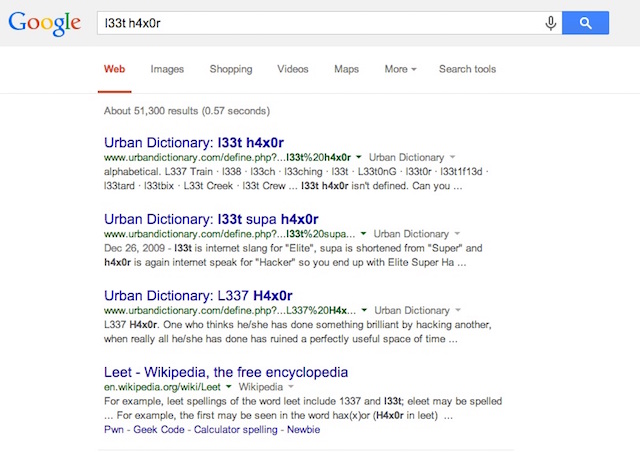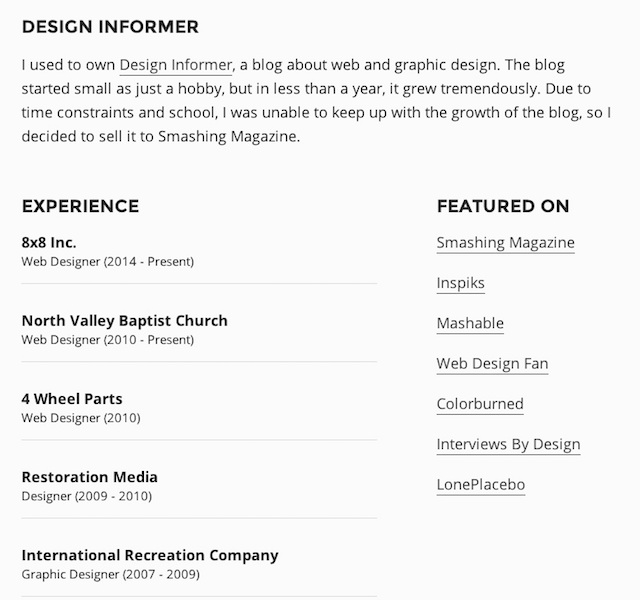Why Your Resume Won't Get You Hired as a Web Developer
Your resume and cover letter are not what’s going to get you an interview.
Employers judge your initial application based on your the quality of your portfolio and online footprint.
Just seeing what kind of work people have done, and what sort of online artifacts they’ve created, is tremendously helpful in getting a sense of what people do and what they’re good (or bad) at. - Jeff Atwood, co-founder, Stack Exchange
Your resume (or LinkedIn) describes to an employer what you’ve done, but employers want to see your work, as live websites, screenshots, git commits, blog posts, presentations, and code snippets.
Employers head straight for your work examples
Here’s how you may think an employer reviews your application:
- Reads through your cover email, thinking that you’re a lovely, polite, articulate individual.
- Reads through your resume, noting your X years of Rails or iOS experience and past experience at a startup or code school.
- If you’ve provided any links, takes a look through those.
- If they like what they see, calls you in for an interview.
Here’s how an employer actually reviews your application:
- Spends 5–10 seconds scanning your resume and cover letter for any notable past positions or qualifications.
- Looks for links to your portfolio, projects and GitHub. If you don’t have these and have no impressive past positions/qualifications, your application gets archived.
- Reviews your portfolio or work links, if it’s sloppy, your application gets archived.
- If they liked your work, does a quick search for your personal site and Twitter to see if you’d be a good culture fit at the company. If they find any red flags, your application gets archived.
- If they like your work or think you show promise and would be a good fit at the company, they add you to their phone interviews shortlist.
See the difference?
Employers know not to waste time reading through hundreds of resumes and cover letters if they can more accurately assess candidates with a quick portfolio review.
Demonstrating your experience up-front and having a solid online footprint massively increases the chance of you getting to a phone interview.
Having no online footprint is a red flag for employers

Given that you’re applying for a job as a web developer, I’d be perplexed if I can’t find any of your work online. I’ve seen hiring managers screen out applicants for this a number of times.
If you have only worked on private projects then it’s completely valid that you might not be able to show work examples. But it’s still important to show something. Maybe screenshots of features that you built, a side project, or a blog post. Otherwise an employer will find it difficult to judge your skill without scheduling an interview, which is a big hurdle for them.
If you have fantastic past experience, or write a passionate, compelling cover email then you might still make it to the next stage. But before then I’d still expect employers to ask you for examples of recent projects that you’ve worked on.
Your online footprint is part of your personal brand
Your brand doesn’t just mean the colors you’ve selected for your website. It’s the way someone feels about you when they view your application. If your application looks sloppy and rushed, the employer is unlikely to feel excited to work with you, expecting that you produce sloppy work. If your application is bursting with awesome projects that you’re passionate about, then a reviewer is going to at least want to speak with you to find out more.
You don’t need to be ranked highly on Google. You just need some sort of a history of past projects and work strewn across the Internet showing off your skills as a developer. Let’s cover some of the ways that you can package these artifacts together to submit as part of your job application.
What work should you include?
When selecting pieces of work to include, it’s good to remember the two most important criteria that employers will judge them by:
- Relevancy
- Awesomeness
If you’re applying to a Front-end Developer position you should show your best examples of any websites/interfaces/features that you’ve built. Especially those that are closest to the work that you’d be producing for the employer.
If you have other awesome projects that you’ve worked on, include one or two of them, too. For example, if you have ops chops, share a blog post on how you configured your server or set up your development environment. Just be careful not to overload your application with too many projects that aren’t relevant to the position you’re applying for, or the hiring manager might find it difficult to see you as a match.
Definitely include (if you have them)
- Your portfolio. If you don’t have a portfolio you really should, it doesn’t need to be fancy. A simple static HTML page will do, showing screenshots and an overview of projects you’ve worked on.
- Recent projects. For each include a screenshot, live example (if possible), link to source code (if public), paragraph explaining what the project is, and what you did on it (keep this part as brief as possible).
- Open source projects. Links to your own projects that you’ve open sourced, project that you’ve worked on as an employee, or any other OS projects that you’ve contributed to.
Other things you might want to include
- Blog posts. These are great for judging your ability to communicate.
- Stack Overflow. Or activity in another relevant community i.e. /r/webdev, codepen, dribbble.
- SlideShare. Any presentations, including Meetups, conferences, or presentations that are a work in progress.
These last three are fantastic for showing off your communication skills and how you talk through problems and code. If you spend a lot of your time helping people out or talking through problems on a forum like Reddit or StackOverflow then consider showing this off. Seeing that you can communicate effectively is a huge plus, this is a great opportunity to show off passion and enthusiasm too.
Prioritize work that’s relevant to the position
The goal of the employer is to hire someone that fits in with the team and produces great work. You should prioritize showing off work that’s as relevant to the position you’re applying for as possible. This will make it easier for the employer to mentally place you in that job role that they sorely need. It can be helpful to take a look back over the job description, or do some research on what technologies the company is using so that you can effectively prioritize any relevant projects that you’ve worked on.
That doesn’t mean you shouldn’t include cool unrelated side projects that rank highly on the awesome scale. Just be sure to prioritize those below your projects that are more relevant to the position. Keep the interviewer’s goal in mind. Seeing a list of unrelated projects might help show the interviewer that you’re smart, but may not help persuade her that you’re a fit for the position you’re applying for. An employer wants to see that you’re excited about the types of technologies they use so they can be sure that you’ll enjoy working with them.
Package and present your work professionally
Given that employers skim read resumes and cover letters, it’s a good idea to clearly highlight the things that you want them to see, making it really easy for them to click through and consume.
Here are four examples of different ways that you could package your footprint (bonus points for doing all four!):
1) Inline in your resume
List out each of the projects that you completed in your resume, or describe them when talking about past positions. Explain your role on the project, what parts of the work you completed and the results of the work (i.e. X installs, Y new users). At the end of this, include a link to the live project, a blog post about it, an online portfolio entry, or a page with screenshots of the work.
2) A bulleted list in your cover email
Include a bulleted list of links (this makes them extremely visible) anywhere in your cover email. If you’re short of time or don’t have a portfolio, this is a really good option.
An example, in the post-script of a cover email:
P.S. Here are four links to things that I enjoyed working on over the last 6 months:
- Homepage of google.com - I integrated search by voice into the Google search bar, using X, Y, Z technologies.
- Learning AngularJS - A blog post I wrote on my learnings so far with Angular.
- My open source dotfiles - I spend a lot of time tweaking my terminal workflow, so decided to share it.
- My Dribbble profile - In my spare time I enjoy working on logo and type design.
3) About page on your site
/about.html is a great place to summarize your online footprint and work that you’d like to show employers.
A few examples of great about pages:
- Jad Limcaco, 8x8 (shown below)
- John Nunemaker, GitHub
- Rafal Tomal, Copyblogger

4) Online Portfolio
An online portfolio is a catalog of your awesomeness. It can be as simple as a static page on your website that highlights your best work. Creating a portfolio is a fantastic way to package your work to show to employers, giving you a lot of control over including screenshots, code snippets and any other information that you’d like to share.
Employers will Google you
You should expect that the employers go to town on Googling you, because they absolutely will. Hiring managers have to do their due diligence to background check candidates online because missing clear cultural red flags would be their fault. It’s also a great first place for them to begin evaluating how you’d fit in at the company.
Make sure to take anything offline that wouldn’t be aligned with the company culturally. That includes anything on your:
- Personal site/portfolio/blog
- GitHub
- Platform specific sites (e.g. Drupal.org)
- Anything other pages that you rank highly for on Google, or they could discover
I’ve know of a number of people that have lost job offers as a direct result of the content that employers found about them online in the application stage. Every company has a line, some are much more stringent than others. Make sure not to cross it. It totally depends on the employer.
Conclusion: Demonstrate your work up-front
Show off your best work in an easily consumable way for the hiring manager. That will put you way ahead of the competition and maximize the chance of you landing a phone interview.
Things to make sure of before you send off that initial application:
- It’s easy for the employer to gauge your technical skill by your work examples.
- It’s easy for the employer to find your work examples in your application. They’re obvious links that they can’t miss.
- You prioritize showing work examples that are relevant to the position.
- Your online footprint is SFW!